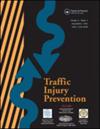Exploring drivers’ psychological responses in spiral tunnel: visual attention and subjective perceptions
IF 1.9
3区 工程技术
Q3 PUBLIC, ENVIRONMENTAL & OCCUPATIONAL HEALTH
引用次数: 0
Abstract
Objective
The objective of this study was to investigate the challenges associated with driving in spiral tunnels through a comprehensive analysis of both visual performance and subjective perceptions of drivers. By comparing driving behavior in spiral tunnels to that in conventional curved tunnels, the study aimed to identify specific differences in visual attention, cognitive processing, and perceived workload, ultimately informing tunnel design and safety improvements.
Methods
Naturalistic driving experiments were conducted in two different tunnel environments: A conventional curved tunnel and a spiral tunnel. Participating drivers were equipped with eye-tracking device to measure visual performance indicators such as average fixation duration, average pupil diameter, average saccade duration, and average saccade amplitude. Additionally, drivers’ subjective perceptions of workload were assessed using the National Aeronautics and Space Administration Task Load Index (NASA-TLX) scale, which evaluates mental, physical, temporal, and emotional demands, as well as overall performance and frustration.
Results
The results of the study revealed significant differences in drivers’ visual performance and subjective perceptions between spiral and curved tunnels. In spiral tunnels, drivers exhibited longer average fixation durations and larger average pupil diameters, indicating increased cognitive processing and visual attention requirements. Furthermore, drivers in spiral tunnels had longer average saccade durations and smaller average saccade amplitudes, suggesting a more cautious and focused visual scanning strategy due to the tight turns and limited visibility. Subjectively, drivers reported significantly higher workload across all dimensions of the NASA-TLX scale in spiral tunnels, indicating greater mental, physical, temporal, and emotional demands compared to curved tunnels.
Conclusions
This study reveals the challenges of spiral tunnels for drivers, especially regarding visual attention and cognitive load. It suggests that improving tunnel design elements like lighting, signage, and road surfaces can lower drivers’ cognitive demands and improve their visual processing. The research also emphasizes the importance of specialized driver training for navigating these tunnels safely. In summary, the findings enhance transportation safety by offering insights into driving behavior in complex tunnels and suggesting methods to reduce risks.
螺旋隧道驾驶员的心理反应:视觉注意与主观知觉。
研究目的本研究的目的是通过全面分析驾驶员的视觉表现和主观感受,研究在螺旋隧道中驾驶所面临的挑战。通过比较螺旋隧道和传统弯道隧道中的驾驶行为,该研究旨在确定视觉注意力、认知处理和感知工作量方面的具体差异,最终为隧道设计和安全改进提供参考:方法:在两种不同的隧道环境中进行了自然驾驶实验:方法: 在两种不同的隧道环境中进行了自然驾驶实验:传统的弯曲隧道和螺旋隧道。参与实验的驾驶员都配备了眼球跟踪装置,用于测量视觉性能指标,如平均固定持续时间、平均瞳孔直径、平均囊状移动持续时间和平均囊状移动幅度。此外,还使用美国国家航空航天局任务负荷指数(NASA-TLX)量表评估了驾驶员对工作量的主观感受:研究结果表明,螺旋形隧道和弧形隧道在驾驶员的视觉表现和主观感受方面存在显著差异。在螺旋形隧道中,驾驶员表现出更长的平均凝视时间和更大的平均瞳孔直径,这表明对认知处理和视觉注意力的要求更高。此外,在螺旋形隧道中,驾驶员的平均囊回持续时间更长,平均囊回振幅更小,这表明由于狭窄的转弯和有限的能见度,驾驶员需要采取更加谨慎和集中的视觉扫描策略。从主观上看,在螺旋形隧道中,驾驶员在NASA-TLX量表的所有维度上的工作量都明显更高,这表明与弧形隧道相比,螺旋形隧道对精神、体力、时间和情绪的要求更高:本研究揭示了螺旋形隧道对驾驶员的挑战,尤其是在视觉注意力和认知负荷方面。研究表明,改进隧道设计元素,如照明、标识和路面,可以降低驾驶员的认知需求,改善他们的视觉处理能力。研究还强调了对驾驶员进行专门培训以安全驾驶这些隧道的重要性。总之,这些研究结果有助于深入了解复杂隧道中的驾驶行为,并提出降低风险的方法,从而提高交通安全。
本文章由计算机程序翻译,如有差异,请以英文原文为准。
求助全文
约1分钟内获得全文
求助全文
来源期刊

Traffic Injury Prevention
PUBLIC, ENVIRONMENTAL & OCCUPATIONAL HEALTH-
CiteScore
3.60
自引率
10.00%
发文量
137
审稿时长
3 months
期刊介绍:
The purpose of Traffic Injury Prevention is to bridge the disciplines of medicine, engineering, public health and traffic safety in order to foster the science of traffic injury prevention. The archival journal focuses on research, interventions and evaluations within the areas of traffic safety, crash causation, injury prevention and treatment.
General topics within the journal''s scope are driver behavior, road infrastructure, emerging crash avoidance technologies, crash and injury epidemiology, alcohol and drugs, impact injury biomechanics, vehicle crashworthiness, occupant restraints, pedestrian safety, evaluation of interventions, economic consequences and emergency and clinical care with specific application to traffic injury prevention. The journal includes full length papers, review articles, case studies, brief technical notes and commentaries.
 求助内容:
求助内容: 应助结果提醒方式:
应助结果提醒方式:


